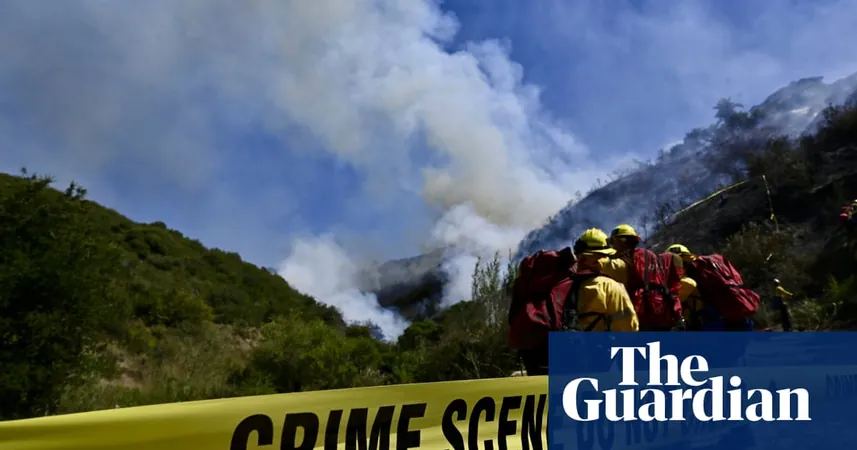
New Revelations from Inquiry: What led to the Catastrophic Titan Sub Implosion?
2024-09-25
Author: Liam
Deep Sea Engineer's Alarming Testimony
The inquiry into the Titanic-bound Titan submersible has taken a gripping turn as deep-sea engineer William Kohnen took the stand this week. Kohnen was one of the maritime experts who penned a cautionary letter in 2018 to OceanGate's CEO, Stockton Rush, warning about the inherent dangers tied to the Titan's design and operation.
Unraveling the Mystery of the Titan's Structural Failures
Investigators are now piecing together how the Titan's structure ultimately compromised its mission. Reports indicate that forensic experts have been diligently examining the wreckage to pinpoint the cause of failure. Significant design flaws have already been identified, including issues with the sub's viewport, which was only rated for depths of 1,300 meters (4,300 feet) — yet Titan was diving nearly three times deeper.
The Titan’s hull, notably cylindrical instead of the more conventional spherical shape, distributed deep-sea pressure unevenly, leaving it vulnerable to catastrophic failure. The hull was constructed from carbon fibre, a material experts deem unreliable for deep-sea conditions. Kohnen explained that this composite fiber would have suffered compression and degradation with each dive, weakening its structural integrity over time.
Adding to the concern were the junctions where different materials converged. The integration of carbon fiber with titanium rings led to potential weak spots that might have contributed to the implosion.
The Loud Bang: A Foreboding Red Flag?
An alarming aspect of the inquiry has been the repeated questioning by the US Coast Guard about a "loud bang" heard during a 2022 dive. Initially dismissed by Stockton Rush as a benign adjustment, data obtained from the Titan’s sensors indicated a different story. Subsequent dives showed the hull was responding abnormally to pressure, suggesting that the bang may have been indicative of a significant failure developing within the hull's structure.
Visual Evidence: Wreckage Analysis
Dr. Don Kramer from the National Transportation Safety Board (NTSB) has presented critical images showcasing the Titan's wreckage on the ocean floor. Highlights of the examination revealed unsettling signs of delamination within the carbon fiber layers—a phenomenon where layers of material separate—especially at points where carbon fiber met titanium. Though Dr. Kramer did not confirm the hull as the first failure point, his emphasis on these materials underlines their importance in the ongoing investigation.
Titan's Financial Strain and Safety Oversights
Amidst engineering concerns, testimony also focused on OceanGate's financial struggles. Amber Bay, the company’s Director of Administration, detailed the dependency on investor funding and passenger fees to maintain operations. Over the years, prices for the dives surged from $150,000 to $250,000 per person as operational costs grew. Interestingly, if customers couldn't glimpse the Titanic, they weren't offered refunds—further leading to a backlog of eager clients waiting for their turn.
The testimony from former director of engineering Phil Brooks painted a dire picture of OceanGate’s financial health, suggesting that economic strains catalyzed safety compromises in their operations, a worrying assertion backed by the desire to continue dives despite potential hazards.
A Survivor's Terrifying Encounter
Karl Stanley, a deep-sea dive company owner, shared his harrowing first-hand experience diving in an early prototype of the Titan in 2019. Complications began when the sub suffered a lightning strike before their descent, an incident Stanley was unaware of. During the dive, he reported unsettling sounds, worrying noises that suggested the carbon fiber bond was failing—an omen that would ultimately prove disastrous. After witnessing a crack in the internal surface of the prototype’s hull, Stanley determined the risks were severe enough to conclude, “OceanGate came very, very close to killing me.”
As the inquiry unfolds, the revelations continue to mount, unraveling a complex narrative of ambition, risk, and fatal oversight. The world awaits further findings that could prove pivotal in enhancing safety and accountability in deep-sea exploration.









 Brasil (PT)
Brasil (PT)
 Canada (EN)
Canada (EN)
 Chile (ES)
Chile (ES)
 Česko (CS)
Česko (CS)
 대한민국 (KO)
대한민국 (KO)
 España (ES)
España (ES)
 France (FR)
France (FR)
 Hong Kong (EN)
Hong Kong (EN)
 Italia (IT)
Italia (IT)
 日本 (JA)
日本 (JA)
 Magyarország (HU)
Magyarország (HU)
 Norge (NO)
Norge (NO)
 Polska (PL)
Polska (PL)
 Schweiz (DE)
Schweiz (DE)
 Singapore (EN)
Singapore (EN)
 Sverige (SV)
Sverige (SV)
 Suomi (FI)
Suomi (FI)
 Türkiye (TR)
Türkiye (TR)
 الإمارات العربية المتحدة (AR)
الإمارات العربية المتحدة (AR)